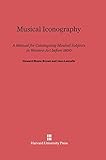Musical Iconography : A Manual for Cataloguing Musical Subjects in Western Art before 1800 / Howard Mayer Brown, Joan Lascelle.
Material type: TextPublisher: Cambridge, MA : Harvard University Press, [2013]Copyright date: ©1972Edition: Reprint 2013Description: 1 online resource (220 p.) : 24 halftonesContent type:
TextPublisher: Cambridge, MA : Harvard University Press, [2013]Copyright date: ©1972Edition: Reprint 2013Description: 1 online resource (220 p.) : 24 halftonesContent type: - 9780674731738
- 9780674731745
- 069/.52
- ML111.B825
- online - DeGruyter
| Item type | Current library | Call number | URL | Status | Notes | Barcode | |
|---|---|---|---|---|---|---|---|
 eBook
eBook
|
Biblioteca "Angelicum" Pont. Univ. S.Tommaso d'Aquino Nuvola online | online - DeGruyter (Browse shelf(Opens below)) | Online access | Not for loan (Accesso limitato) | Accesso per gli utenti autorizzati / Access for authorized users | (dgr)9780674731745 |
Frontmatter -- PREFACE -- CONTENTS -- ILLUSTRATIONS -- I. WHAT CAN WORKS OF ART TEACH US ABOUT MUSIC? -- II. Introduction -- III. FORMING THE LOCATOR SYMBOL -- IV. KIND OF REPRODUCTION AVAILABLE -- V. ARTIST AND HIS DATES -- VI. SCHOOL AND DATE OF WORK OF ART -- VII. TITLE OF WORK OF ART -- VIII. MEDIUM OR TYPE OF OBJECT -- IX. PRESENT LOCATION OF WORK OF ART -- Χ. SIZE OF WORK OF ART -- XI. BIBLIOGRAPHY: SOURCES WHICH CONTAIN REPRODUCTIONS OR DISCUSSIONS -- XII. DESCRIPTION OF WORK OF ART -- XIII. SUBJECT ENTRIES -- XIV. CLASSIFICATION SCHEME FOR PICTURES OF MUSICAL INSTRUMENTS -- APPENDICES Aids to Cataloguing Works of Art with Musical Subjects
restricted access online access with authorization star
http://purl.org/coar/access_right/c_16ec
Musicologists have increasingly recognized that works of art can teach them a great deal not only about music in earlier ages but especially about the place of musical instruments in the civilization of the Middle Ages and the Renaissance. Pictorial representations provide valuable evidence concerning the instruments that were available and the manner in which music was performed in various places at various times. The material is abundant but, until now, it has been difficult to organize. Authors Brown and Lascelle started to collect reproductions of works of art with musical subjects and to compile an index of what they had collected; but found they first had to devise a uniform cataloguing system that would be applicable to all kinds of works and would make available quickly and easily the information needed by students of music. They describe in detail their system, which has worked beautifully for all of the objects they have catalogued.
Mode of access: Internet via World Wide Web.
In English.
Description based on online resource; title from PDF title page (publisher's Web site, viewed 24. Aug 2021)


